A creeping darkness envelops the stage while an anxious throng of people await, transfixed on the precipice before them. Moments pass and time stretches ever thinner, pulled inexorably apart by the tightening grip of anticipation. Suddenly, almost imperceptibly, a stirring echoes faintly from the emptiness.
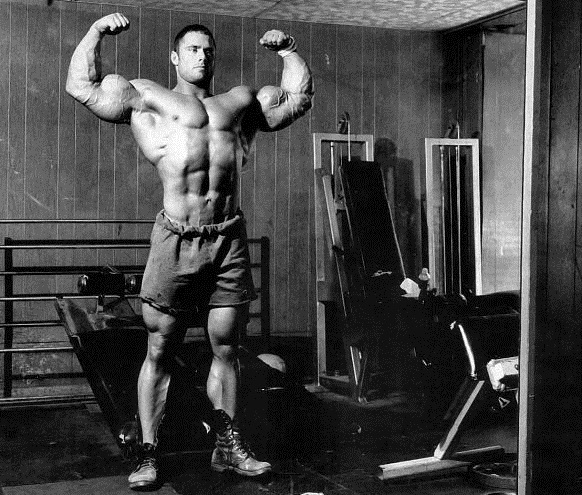
From far above, a light pierces through the black like a lightning bolt, illuminating a shrouded figure that has come to a stop, front and center. At first glance, the vision seems impossible. It has arms, legs, a head, a torso, but could it be human? How? Every muscle bulges in staggering detail, each blown up to grotesque proportion. Thick bands of sinew and tendon struggle to hold the pieces together, as if sewn and stapled in place by Dr. Frankenstein himself. Paper-thin skin covers the creature, which looks to be nothing short of 300 pounds.
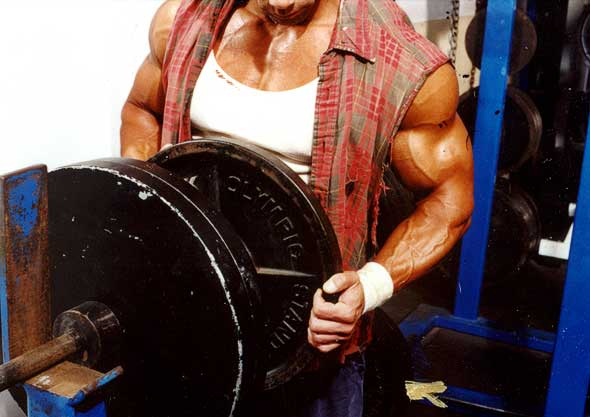
Monsters such as these are built within the deep confines of iron dungeons across the globe, from Texas to Transylvania and every recess in between. They are crafted repetition by brutal repetition, set by searing set, with primitive instruments of torture barbells, dumbbells and plates.
They are fueled by uncommon means, with an insatiable appetite for meat and energy, and they are intensely driven by a voracious quest for size. It is not a haphazard journey from mere mortal to bodybuilding behemoth. Although most of us can only dream to attain the freakish wicked mass of a competitive pro, we all can traverse the primal path they have pursued, undertaking the same nutritional strategies that build such beasts.
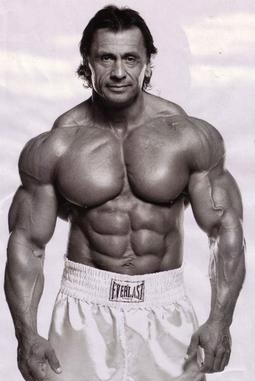
Is it crazy to want to? No matter. To be big and we mean scary big requires a touch of madness.
Back To The Lab
Piecing together a mad mass plan is almost frighteningly simple, at least in concept: first, you have to eat the right amount of food at particular times of day; second, you have to eat the right types of food at specific times of day. Doing one or the other isn’t enough. Look no further than the hardgainer who carefully chooses the right foods for his diet, but never packs away enough of them in one sitting; or the guy who goes overboard in his weight-gain quest, eating everything in sight until his belly becomes his biggest bodypart. In contrast, an ideal mass-building plan, one that allows you to grow without turning into a slobbering ogre, requires a more methodical approach, which is outlined in the following nine “experiments.”
Try them for yourself, noting the effects each step has on your physique. In the end, you’ll have assembled a full-blown muscle-building nutrition program.
Experiment #1 | Multiply your meals.
You won’t be able to maximize growth by eating only three, four or even five meals a day. Instead, you need to ramp up to six or seven (see “Monster Mass Meal Plan” sidebar on page 98). The benefits are multifaceted. Smaller meals are absorbed more readily by your body, which means you actually get far more of the amino acids, vitamins and minerals from your food than you do when you eat fewer larger meals per day.
More frequent meals help increase testosterone and insulin levels hormones that promote growth while driving down cortisol levels, a growth-inhibiting hormone that is released during training and in response to other stresses.
Experiment #2 | Get your protein intake up to par.
Protein is made up of amino acids, the basic components of muscle tissue. Thus, you need to have plenty of amino acids available so that your body can build muscle at its maximal rate. It’s key, then, that you take this advice to heart (if you’ve been reading Simplyshredded.com for a while, you know that we’ve stressed this many times): you need to consume at least a gram of protein per pound of bodyweight each day. If you weight 180 pounds, you need at least 180 grams (g) of protein in your daily diet. That’s 26-30 g of protein per meal, equivalent to about five ounces (precooked weight) of chicken breast or a cup of lowfat cottage cheese.
It’s easy math, but so many monster wannabes fall short on protein intake, and their results suffer dramatically.
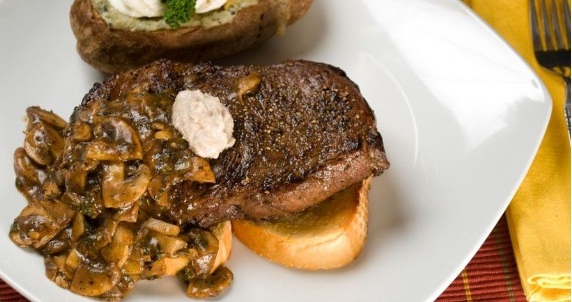
Experiment #3 | Manipulate your protein intake for key times of the day.
Follow the “1 g per pound rule” for two or three weeks. At that point, if you’re still not seeing gains, adjust your protein consumption at two critical times: after training and in the middle of the night. After workouts, bump up your protein intake to 40-60 g, preferably using a fast-acting whey protein source; at midnight (set the alarm if you hit the sack early), guzzle a 30-40 g protein shake. The late-night feeding will help keep you in an anabolic state overnight. Otherwise, it’s a long fast for your body from one meal to the next.
Experiment #4 | Crank up your carbohydrates.
Carbs work with protein, creating a hormonal environment conducive to growth. They help the process of transporting amino acids from food into your muscles so they can be made into new muscle tissue or used to repair tissue damaged during training, and they are stored in your muscles as glycogen, a powerful energy source. Start with 2 g of carbs per pound of bodyweight each day. But, unlike protein, split this over your first five or six meals of the day, dropping carbs from your last meal or two of the day. Thus, a 180-pounder should eat 60-72 g of carbs at each of his first five or six daily meals, with minimal carbs after that.
Experiment #5 | Adjust your carbs at key points of the day.
 Follow the “2 g per pound rule” for two or three weeks. Then, if your results are lagging, bump up your carb intake at two critical junctures: the first meal of the day and after training. By the fifth week, if you haven’t seen improvements, boost your carb intake to a total of 2 1/2 g per pound of body weight daily. Increasing carbs at breakfast, when they’re coupled with protein, helps put a stop to the protein breakdown that occurs during the last two or three hours of sleep and kick-starts your metabolism. (Contrary to common misconceptions, an elevated metabolism actually increases muscle growth.)
Follow the “2 g per pound rule” for two or three weeks. Then, if your results are lagging, bump up your carb intake at two critical junctures: the first meal of the day and after training. By the fifth week, if you haven’t seen improvements, boost your carb intake to a total of 2 1/2 g per pound of body weight daily. Increasing carbs at breakfast, when they’re coupled with protein, helps put a stop to the protein breakdown that occurs during the last two or three hours of sleep and kick-starts your metabolism. (Contrary to common misconceptions, an elevated metabolism actually increases muscle growth.)
Boost your carb intake at breakfast and after your workouts by 50%. For example, if you were eating 60 g at breakfast, increase it to 90 g.
Experiment#6 | Focus your fat consumption.
A common mistake among those trying to gain lean mass is in not distinguishing between good and bad fats. The truth is not all fats are created equal. Healthy fats monounsaturated fats, omega 3s and 6s can be a huge boost to body builders who are trying to gain quality size. Emphasize the following foods in your diet: avocados, salmon and other fatty fish, nuts and seeds, and healthy oils, such as canola and olive. Reduce other fats, while continuing to consume those contained in lean red meat, chicken breast, turkey breast and whole eggs (including the yolk), because you do need some saturated fat and cholesterol for muscle growth.
Experiment #7 | Be a fiber fanatic.
Consuming a ton of fiber won’t help you get huge in and of itself, but it will help you better process the foods you do eat. The digestive systems of hardgainers on mass diets often have trouble handling all the additional calories. Fiber can help you get the most out of your nutrition program. Vegetables, beans, oatmeal and brown rice are all high in fiber, and they’re good sources of complex carbs. Including these foods at most meals (except before and after workouts) will help you put on size.
As a rule, strive to take in up to six servings of vegetables a day, such as broccoli, spinach, carrots and asparagus. You should be able to easily consume two or three servings with a meal.
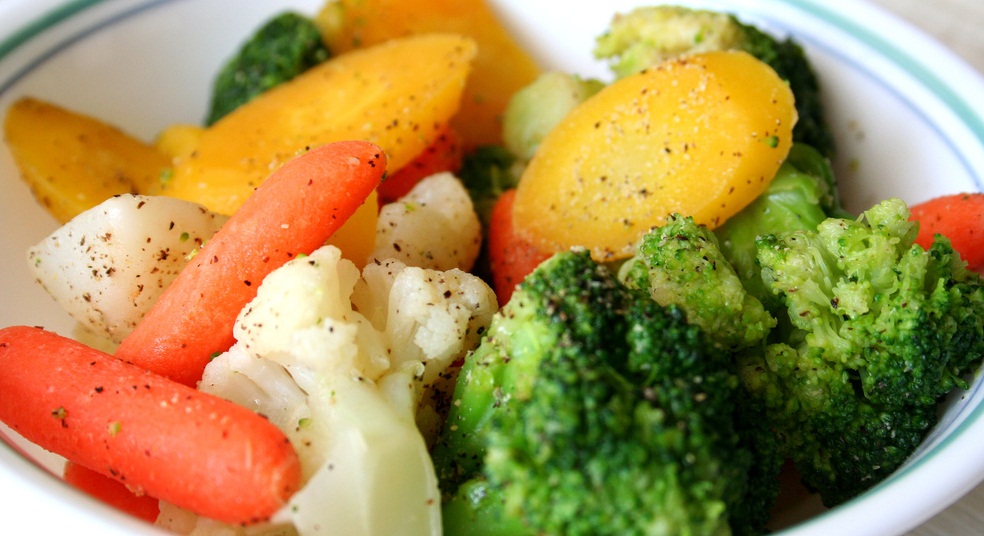
Experiment #8 | Hydrate.
Even if we’re always carrying gallon jugs of water around the gym, most of us are usually in a constant state of mild dehydration. Many people just don’t drink enough water, period. If you want to get big, you need to stay hydrated, because doing so pumps your muscles full of fluids, increasing strength, performance and, ultimately, progress; this will also assist your digestive system in processing food. Strive to drink a gallon of water a day. In addition to water itself, other fluids help keep your body hydrated, including green tea, sports drinks, milk, sparkling water and Crystal Light, as well as other diet drinks.
Experiment #9 | Size up your supplement regimen.
A lot of guys make one of two mistakes when it comes to supplementing for muscle gains; they either overrely on supplements or they underrely on supplements (or don’t use them at all). Avoid either error by following the guidelines in the “Monster Mass Supplement Regimen” sidebar.
The Mad Scientist
Whether you take on these experiments piece by piece to create your own formula for growth or use the guidelines set out in the “Monster Mass Eight-Week Plan,” the changes will help you avoid the horrors associated with working your ass off in the gym but having nothing to show for it. Nutrition can make or break you, and it’s often the difference between living your bodybuilding dreams and watching those dreams turn to a nightmarish skin-and-bones reality. Like those monsters who step out onto pro bodybuilding stages, you, too, can scare up additional muscle mass, but only if you’re ready and willing to fight for it every step of the way.
Monster Mass Supplement Regimen
Growth of gigantic proportions can be achieved with food alone, but you can make your journey easier with the help of supplements, as suggested in experiment #9. Here are some of the proven basics to help lay the foundation for extreme growth.
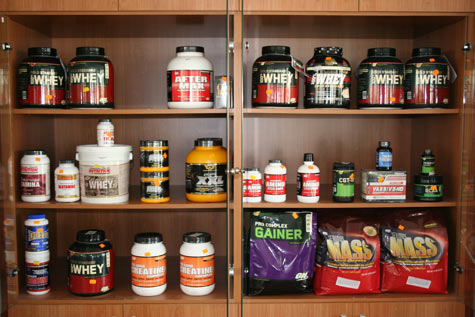
Protein Shakes
These provide one of the easiest ways to assist your muscle-building program. It can be challenging (and expensive) for young bodybuilders to get in all the protein they need from whole-food protein sources. To supplement your whole-food intake, drink up to three protein shakes a day pre- and postworkout and before bed are great times to rely on a protein-powder concoction.
Dosage:
Down a protein shake 25 g of whey protein and 50 g of simple carbs before you work out and then another after. Before bed, use a product that has about 25 g of casein protein.
Creatine
This supplement boasts numerous benefits for health, recovery and muscle building. When taken before workouts, it helps drive nutrients and fluids into your muscles, helping you to lift more weight or get extra reps. Ultimately, this effect helps build more strength and muscle mass.
Dosage:
Take 3-5 g of creatine before and after your workouts, for up to 10 g per day.
Glutamine
The most prevalent amino acid in the body, glutamine promotes a healthy immune system response for better recovery from training. It also enhances digestion and protects muscle mass from breaking down, which is likely to occur when your body perceives a glutamine shortage.
Dosage:
Take 5-10 g of glutamine first thing in the moming, before and after training, and before bed.
Arginine
This helps promote a pump the full muscular sensation you get when your target muscles are engorged with blood and fluids by “opening up” your circulatory system. The influx of fluids delivers nutrients to muscles and helps encourage growth.
Dosage:
Take 3-5 g of arginine about 30 minutes before you work out and two more doses at other times of the day.
BCAA’s
The branched-chain amino acids are leucine, isoleucine and valine. These key aminos not only specifically support muscle growth, but they also help maintain muscle mass during a dieting phase.
Dosage:
Take doses of 5-10 g of BCAAs on an empty stomach in the morning, as well as before and after workouts.
Multivitamin/Multimineral pack or pill
Think of these as insurance policies the demands of a bodybuilding lifestyle can cause shortages in specific vitamins or minerals. A good multi will contain vitamins C, D and E, as well as a range of vitamin Bs and minerals.
Dosage:
Take a multivitamin/multimineral pack or pill once or twice a day with food. Look for brands that provide 100% of the daily value of C, D, E, most Bs, zinc, copper and chromium.
Monster Mass Meal Plan
Breakfast
- 1 cup of oatmeal
- 4 whole eggs
- 2-3 slices of low-fat breakfast meat
- 1 piece of fruit
Midmorning
- 2 ounces of nuts (your choice)
- 1 ounce of dried fruit
Lunch
- 6 ounces of chicken breast
- 2 slices of whole-grain bread
- Vegetable side dish (low-fat coleslaw, salad or steamed vegetable)
Preworkout
- 25 g of whey protein shake
- 50 g of simple carbs
Postworkout
- 25 g of whey protein shake
- 50 g of simple carbs
Dinner
- 8 ounces of lean steak
- Small baked potato or small portion of steamed rice (white or brown)
- Salad with olive oil and avocado
Bedtime
- 25 g of casein protein shake
Monster Mass 8 Week Plan
Here’s a week-by-week checklist of the core nutrition and supplement strategies you should include daily while you’re on the Monster Mass program. Every two weeks, you’ll make a significant change in either the amount of food that you are consuming or in the addition of new supplements (those differences are in bold type). Staggering the addition of different supplements this way allows your body time to respond to them. Most bodybuilders see better results from this strategy than they do from including all supplements from day one of a program.
As your body begins to accommodate to the plan, providing new stimulation (in the form of supplements) every two weeks will help prevent you from plateauing and help you keep growing for a longer period of time.

Week One
- Eat at least six meals per day
- Include a protein shake (25 g of whey and 50 g of simple carbs) before and after your workouts
- Drink a 25 g casein protein shake before bedtime
- Drink a gallon of water throughout the day
- Take a multivitamin/multimineral pack with breakfast
Week Two
- Continue to eat at least six meals a day
- Include a protein shake (25 g of whey and 50 g of simple carbs) before and after your workouts
- Drink a 25 g casein protein shake before bedtime
- Drink a gallon of water throughout the day
- Take a multivitamin/multimineral pack twice daily
Week Three
- Make adjustments in your carbohydrate consumption if necessary (see experiment #4)
- Eat at least six meals per day
- Include a protein shake (25 g of whey and 50 g of simple carbs) before and after your workouts
- Drink a 25 g casein protein shake before bedtime
- Take a multivitamin/multimineral pack or pill twice daily
- Drink a gallon of water throughout the day
- Take a 3-5 g dose of creatine before your workouts
Week Four
- Consume the same amount of carbohydrates as in week three
- Eat at least six meals per day
- Include a protein shake (25 g of whey and 50 g of simple carbs) before and after your workouts
- Drink a 25 g casein protein shake before bedtime
- Take a multivitamin/multimineral pack or pill twice daily
- Drink a gallon of water throughout the day
- Take a 3-5 g dose of creatine before and after your workouts
Week Five
- Make adjustments in carbohydrate consumption if necessary
- Eat at least six meals per day
- Include a protein shake (25 g of whey and 50 g of simple carbs) before and after your workouts
- Drink a 25 g casein protein shake before bedtime
- Take a multivitamin/multimineral pack or pill twice daily
- Drink a gallon of water throughout the day
- Take a 3-5 g dose of creatine before and after your workouts
- Take one or two doses (3-5 g each) of arginine daily
- Take up to three doses (5-10 g each) of glutamine daily
Week Six
- Consume the same amount of carbohydrates as in week five
- Eat at least six meals per day
- Include a protein shake (25 g of whey and 50 g of simple carbs) before and after your workouts
- Drink a 25 g casein protein shake before bedtime
- Take a multivitamin/multimineral pack or pill twice daily
- Drink a gallon of water throughout the day
- Take a 3-5 g dose of creatine before and after your workouts
- Take up to three doses (3-5 g each) of arginine daily
- Take up to four doses (5-10 g each) of glutamine daily
Weeks Seven and Eight
- Consume the same amount of carbohydrates as in week five
- Eat at least six meals per day
- Include a protein shake (25 g of whey and 50 g of simple carbs) before and after your workouts
- Drink a 25 g casein protein shake before bedtime
- Take a multivitamin/multimineral pack or pill twice daily
- Drink a gallon of water throughout the day
- Take a 3-5 g dose of creatine before and after your workouts
- Take up to three doses (3-5 g each) of arginine daily
- Take up to four doses (5-10 g each) of glutamine daily
- Take three doses (5-10 g each) of BCAAs daily
Beyond Eight Weeks
If you are continuing to make progress on your Monster Mass plan and want to keep going and growing, stay with it for as long as it works. Visually monitor your bodyfat stores. If you appear to be adding more bodyfat than muscle mass, then that may mean your body is telling you that this mass-building phase has come to its end. At this time, begin to experiment with bodyfat reduction. (After following a calorie-cutting diet, you may be surprised to see how much real muscle mass you’ll have packed on via the Monster Mass program.)
Keep reading Simplyshredded.com for all our muscle-building and bodyfat-reducing programs. Remember, the best way to continue to make progress is to alternate between growth and bodyfat-reducing phases. Your muscle mass will grow better when you change the stimulus that you provide it every two to three months than if you stay on one type of program indefinitely.
Author: Chris Aceto
Websites: Procardnutrition.com & Flexonline.com
COPYRIGHT 2010 Weider Publications
COPYRIGHT 2010 Gale, Cengage Learning










